Investigation of a High-Temperature Heat Pump for Heating Purposes
Abstract
:1. Introduction
2. Material and Methods
2.1. The Examined Space Heating Systems
2.2. The Examined Buildings
2.3. Basic Mathematical Formulation Part
2.3.1. Heat Pump Modeling
2.3.2. Building and Boiler Modeling
2.3.3. Evaluation Metrics
2.4. Summary of the Followed Methodology
3. Results and Discussion
3.1. Thermodynamic Analysis of the Heat Pump
3.2. System Performance Comparison for Both Climate Zones
3.3. Comparison with the Oil Boiler System
4. Conclusions
- -
- The mean yearly COP was found at 2.128 for Athens, while it was found at 2.013 for Thessaloniki. This difference is justified by the lower ambient temperatures in Thessaloniki. The primary energy savings for Athens was found at 17,588 kWh, and, for Thessaloniki, it was found at 9857 kWh. The reduction of the primary energy demand with the heat pump compared to the oil boiler case was found at 7.1% for Athens and 3.1% for Thessaloniki.
- -
- The economic analysis showed that the use of a heat pump is a feasible choice that presented a simple payback period of 8.03 years in Athens and 6.11 years in Thessaloniki. The lifecycle analysis indicated net present savings of EUR 6448 in Athens and EUR 13,161 in Thessaloniki. The higher profit in Thessaloniki is justified by the higher heating demand in Thessaloniki.
- -
- The environmental analysis proved significant benefits with the use of the air-to-water heat pump, which led to a CO2 emissions reduction of 35% in Athens and 32% in Thessaloniki. The lifetime CO2 emissions avoidance was found at 20,882 kgCO2 for Athens and 35,278 kgCO2 for Thessaloniki.
Author Contributions
Funding
Institutional Review Board Statement
Informed Consent Statement
Data Availability Statement
Conflicts of Interest
Nomenclature
| cp | Specific heat capacity, kJ/kgK |
| C0 | Investment cost, EUR |
| h | Specific enthalpy, kJ/kg |
| hin | Convection coefficient inside the building, W/m2 K |
| hout | Heat convection coefficient with outdoor air, W/m2 K |
| Hu | Lower heating value of the oil, kJ/kg |
| k | Thermal conductivity, W/mK |
| kel | Electricity cost, EUR/kWhel |
| koil | Oil cost, EUR/kWhth |
| L | Thickness of material in a structural element, m |
| LCC | Life cycle cost, EUR |
| m | Mass flow rate, kg/s |
| Μ | Number of layers in every structural element |
| N | Lifetime of the project, years |
| NS | Net savings, EUR |
| p | Pressure, bar |
| Pel | Electricity demand on the compressor, kW |
| PE | Primary energy, kWh |
| Qb | Boiler energy demand, kW |
| Qheat | Heating demand, kW |
| Qin | Heat input in the heat pump from the ambient, kW |
| r | Discount factor, % |
| s | Specific entropy, kJ/kgK |
| SPP | Simple payback period, years |
| T | Temperature, °C |
| U | Thermal transmittance, W/m2 K |
| YCO2 | Yearly CO2 emissions, kgCO2/year |
| Greek Symbols | |
| ηb | Boiler efficiency |
| ηis | Isentropic efficiency |
| ρ | Density, kg/m3 |
| Subscripts | |
| am | Ambient |
| b | Boiler |
| Bitzer | Data from the Bitzer manufacturer |
| cond | Condenser |
| evap | Evaporator |
| HP | Heat pump |
| is | Isentropic |
| Abbreviations | |
| ACH | Air changes per hour |
| COP | Coefficient of performance |
| GWP | Global warming potential |
| ODP | Ozone depleting potential |
| SCOP | Seasonal coefficient of performance |
References
- Wu, D.; Hu, B.; Wang, R.Z. Vapor compression heat pumps with pure Low-GWP refrigerants. Renew. Sustain. Energy Rev. 2021, 138, 110571. [Google Scholar] [CrossRef]
- Cui, M.; Cheng, Z.; Wang, B.; Wei, F.; Shi, W. Experimental investigation on an auto-cascade quasi two-stage compression heat pump system. Appl. Therm. Eng. 2023, 219, 119498. [Google Scholar] [CrossRef]
- Wang, L.; Chen, Z.; Qin, C.; Gu, Y. Economic analysis of gas heat pump in different building applications: A case study in Shanghai. Case Stud. Therm. Eng. 2022, 38, 102303. [Google Scholar] [CrossRef]
- Ahmadi, M.H.; Ahmadi, M.A.; Sadatsakkak, S.A. Thermodynamic analysis and performance optimization of irreversible Carnot refrigerator by using multi-objective evolutionary algorithms (MOEAs). Renew. Sustain. Energy Rev. 2015, 51, 1055–1070. [Google Scholar] [CrossRef]
- Naumann, G.; Schropp, E.; Gaderer, M. Life Cycle Assessment of an Air-Source Heat Pump and a Condensing Gas Boiler Using an Attributional and a Consequential Approach. Procedia CIRP 2022, 105, 351–356. [Google Scholar] [CrossRef]
- Parrish, B.; Hielscher, S.; Foxon, T.J. Consumers or users? The impact of user learning about smart hybrid heat pumps on policy trajectories for heat decarbonisation. Energy Policy 2021, 148, 112006. [Google Scholar] [CrossRef]
- Lämmle, M.; Bongs, C.; Wapler, J.; Günther, D.; Hess, S.; Kropp, M.; Herkel, S. Performance of air and ground source heat pumps retrofitted to radiator heating systems and measures to reduce space heating temperatures in existing buildings. Energy 2022, 242, 122952. [Google Scholar] [CrossRef]
- Hao, X.; Zhang, G.; Chen, Y.; Zou, S.; Moschandreas Demetrios, J. A combined system of chilled ceiling, displacement ventilation and desiccant dehumidification. Build. Environ. 2007, 42, 3298–3308. [Google Scholar] [CrossRef]
- Imanari, T.; Omori, T.; Bogaki, K. Thermal comfort and energy consumption of the radiant ceiling panel system: Comparison with the conventional all-air system. Energy Build. 1999, 30, 167–175. [Google Scholar] [CrossRef]
- Catalina, T.; Virgone, J.; Kuznik, F. Evaluation of thermal comfort using combined CFD and experimentation study in a test room equipped with a cooling ceiling. Build. Environ. 2009, 44, 1740–1750. [Google Scholar] [CrossRef]
- Wang, Z.; Li, G.; Wang, F.; Zhang, Y. Performance investigation of a transcritical CO2 heat pump combined with the terminal of radiator and floor radiant coil for space heating in different climates, China. J. Build. Eng. 2021, 44, 102927. [Google Scholar] [CrossRef]
- Shao, S.; Zhang, H.; You, S.; Zheng, W.; Jiang, L. Thermal performance analysis of a new refrigerant-heated radiator coupled with air-source heat pump heating system. Appl. Energy 2019, 247, 78–88. [Google Scholar] [CrossRef]
- Hu, B.; Wang, R.Z.; Xiao, B.; He, L.; Zhang, W.; Zhang, S. Performance evaluation of different heating terminals used in air source heat pump system. Int. J. Refrig. 2019, 98, 274–282. [Google Scholar] [CrossRef]
- Luo, J.; Xue, W.; Shao, H. Thermo-economic comparison of coal-fired boiler-based and groundwater-heat-pump based heating and cooling solution—A case study on a greenhouse in Hubei, China. Energy Build. 2020, 223, 110214. [Google Scholar] [CrossRef]
- Shah, N.N.; Wilson, C.; Huang, M.J.; Hewitt, N.J. Analysis on field trial of high temperature heat pump integrated with thermal energy storage in domestic retrofit installation. Appl. Therm. Eng. 2018, 143, 650–659. [Google Scholar] [CrossRef]
- Le, K.X.; Huang, M.J.; Shah, N.; Wilson, C.; Mac Artain, P.; Byrne, R.; Hewitt, N.J. High Temperature Air Source Heat Pump Coupled with Thermal Energy Storage: Comparative Performances and Retrofit Analysis. Energy Procedia 2019, 158, 3878–3885. [Google Scholar] [CrossRef]
- Carella, A.; D’Orazio, A. The heat pumps for better urban air quality. Sustain. Cities Soc. 2021, 75, 103314. [Google Scholar] [CrossRef]
- Carella, A.; Del Ferraro, L.; D’Orazio, A. Air/Water Heat Pumps in Existing Heating and Hot Water Systems for Better Urban Air Quality and Primary Energy Savings: Scenarios of Two Italian Cities. Energies 2023, 16, 377. [Google Scholar] [CrossRef]
- Shao, S.; Zhang, H.; Zheng, W.; You, S.; Wang, Y. Numerical and experimental investigations on heat transfer performance of the refrigerant-heated radiator. Appl. Therm. Eng. 2020, 179, 115748. [Google Scholar] [CrossRef]
- Abedini, H.; Vieren, E.; Demeester, T.; Beyne, W.; Lecompte, S.; Quoilin, S.; Arteconi, A. A comprehensive analysis of binary mixtures as working fluid in high temperature heat pumps. Energy Convers. Manag. 2023, 277, 116652. [Google Scholar] [CrossRef]
- Adamson, K.M.; Walmsley, T.G.; Carson, J.K.; Chen, Q.; Schlosser, F.; Kong, L.; Cleland, D.J. High-temperature and transcritical heat pump cycles and advancements: A review. Renew. Sustain. Energy Rev. 2022, 167, 112798. [Google Scholar] [CrossRef]
- Mota-Babiloni, A.; Navarro-Esbrí, J.; Molés, F.; Cervera, Á.B.; Peris, B.; Verdú, G. A review of refrigerant R1234ze(E) recent investigations. Appl. Therm. Eng. 2016, 95, 211–222. [Google Scholar] [CrossRef]
- EES: Engineering Equation Solver|F-Chart Software: Engineering Software. n.d. Available online: https://fchartsoftware.com/ees/ (accessed on 17 December 2022).
- Welcome|TRNSYS: Transient System Simulation Tool. n.d. Available online: https://www.trnsys.com/ (accessed on 17 December 2022).
- List of Refrigerants. Wikipedia 2023. Available online: https://en.wikipedia.org/wiki/List_of_refrigerants (accessed on 17 December 2022).
- Welcome to BITZER. n.d. Available online: https://www.bitzer.de/gr/en/ (accessed on 17 December 2022).
- BITZER Software. n.d. Available online: https://www.bitzer.de/websoftware/Default.aspx (accessed on 17 December 2022).
- Greek Technical Chamber. Available online: http://portal.tee.gr/portal/page/portal/SCIENTIFIC_WORK/GR_ENERGEIAS/kenak/files/TOTEE_20701-1_2017_TEE_1st_Edition.pdf (accessed on 17 December 2022).
- Bellos, E.; Lykas, P.; Tzivanidis, C. Theoretical Analysis of a Biomass-Driven Single-Effect Absorption Heat Pump for Heating and Cooling Purposes. Appl. Syst. Innov. 2022, 5, 99. [Google Scholar] [CrossRef]
- ISO 7730, 2005. ISO. n.d. Available online: https://www.iso.org/standard/39155.html (accessed on 17 December 2022).
- DAPEEP. n.d. Available online: https://www.dapeep.gr/ (accessed on 17 December 2022).
- Heat Pumps YDOR. n.d. Available online: https://www.ydor.com.gr/antlies-thermotitas/?gclid=CjwKCAiAp7GcBhA0EiwA9U0mtkyRiiUfH5m8RsWav7hpm85YOuhnNqXMx851rw63fKlo_KWaUNVcxRoCgzwQAvD_BwE&f2--=6-kw&page=2 (accessed on 17 December 2022).

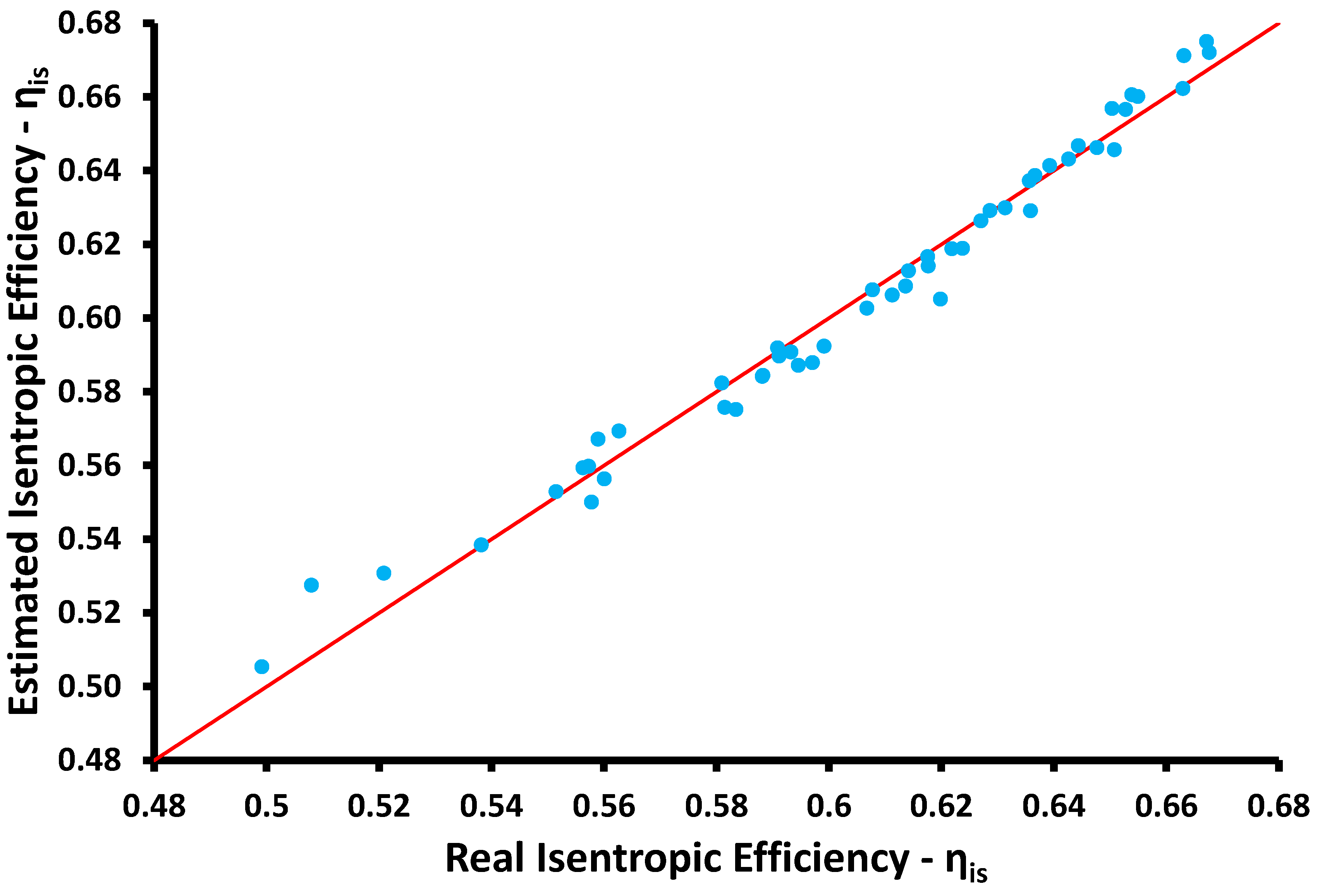

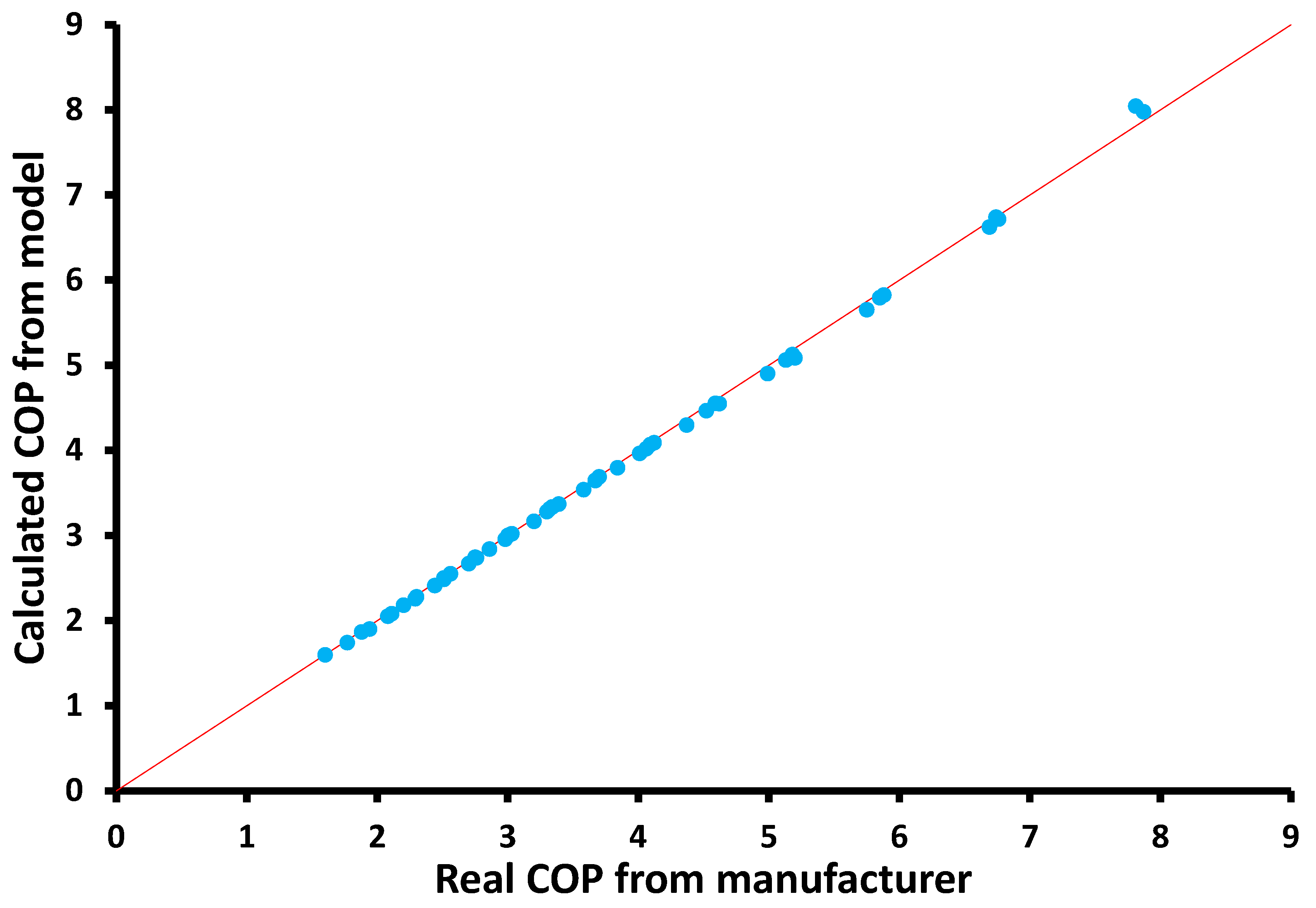
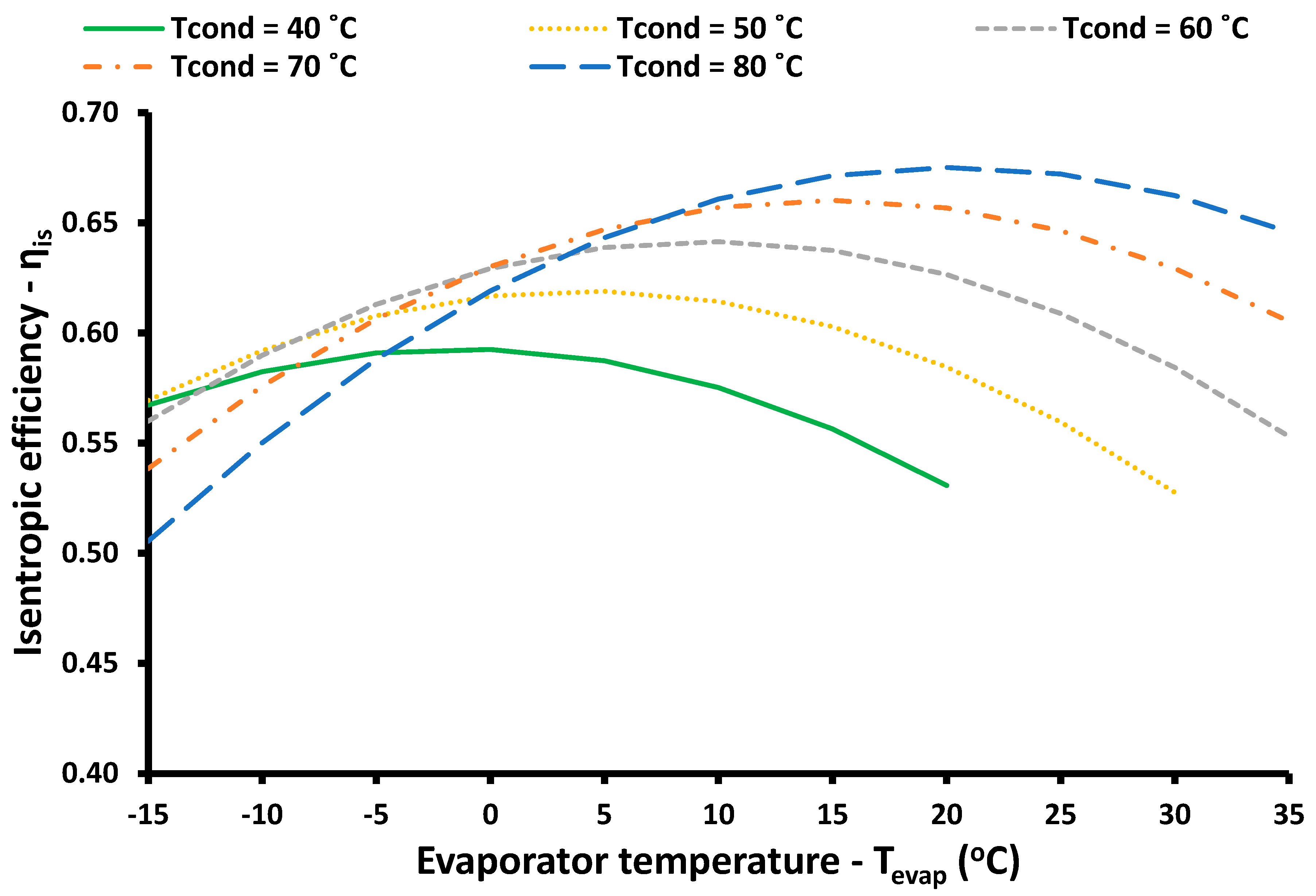
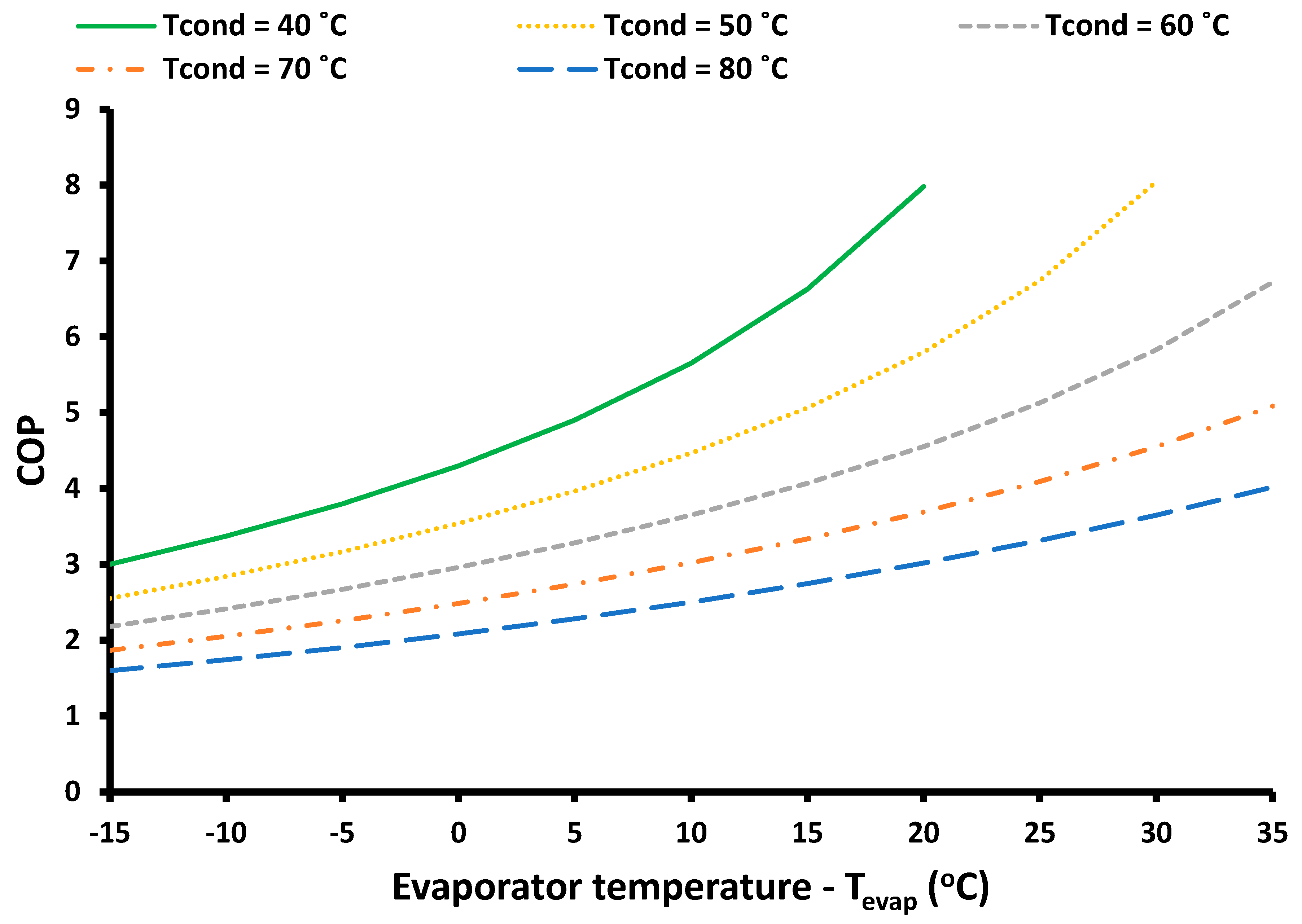
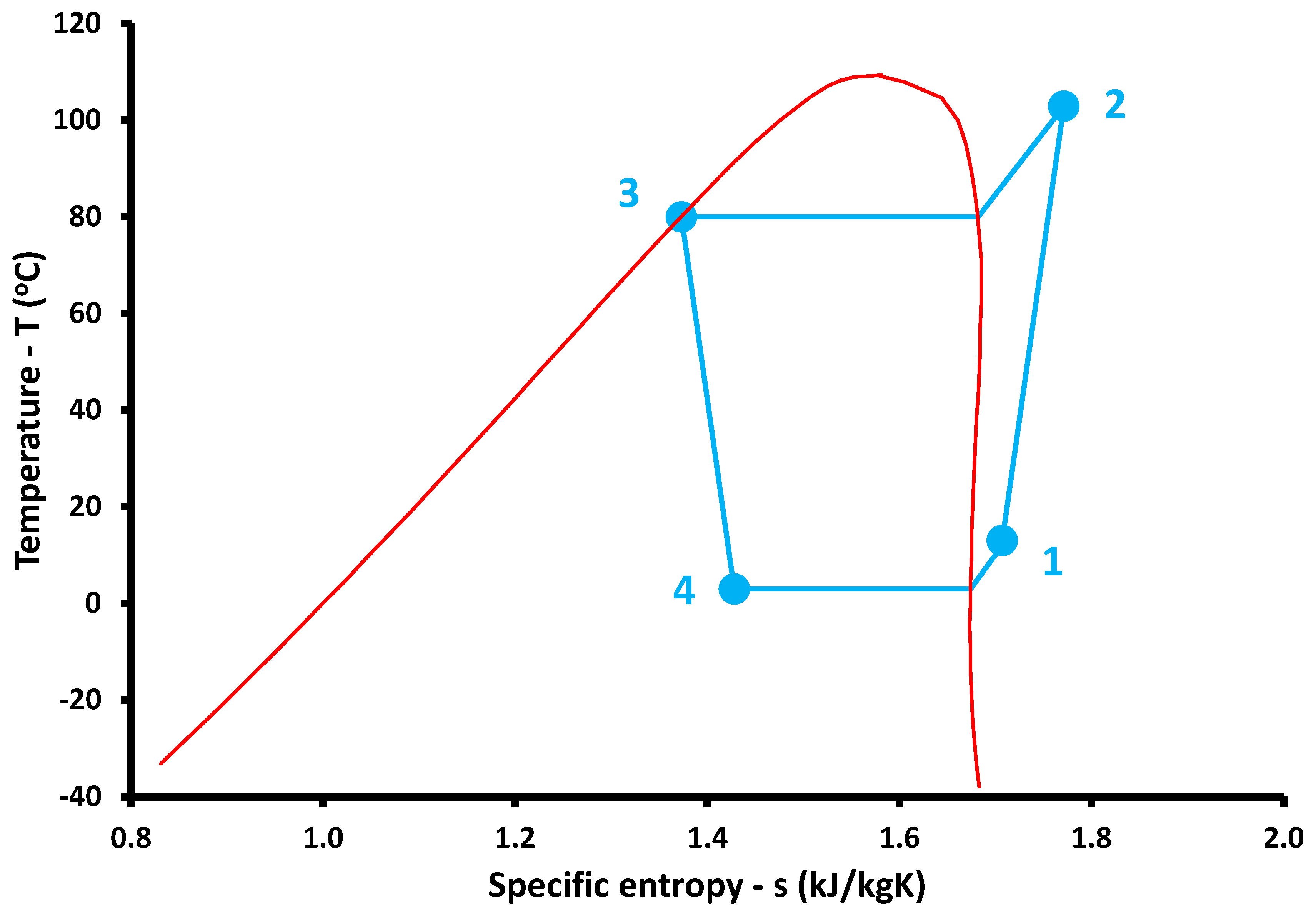
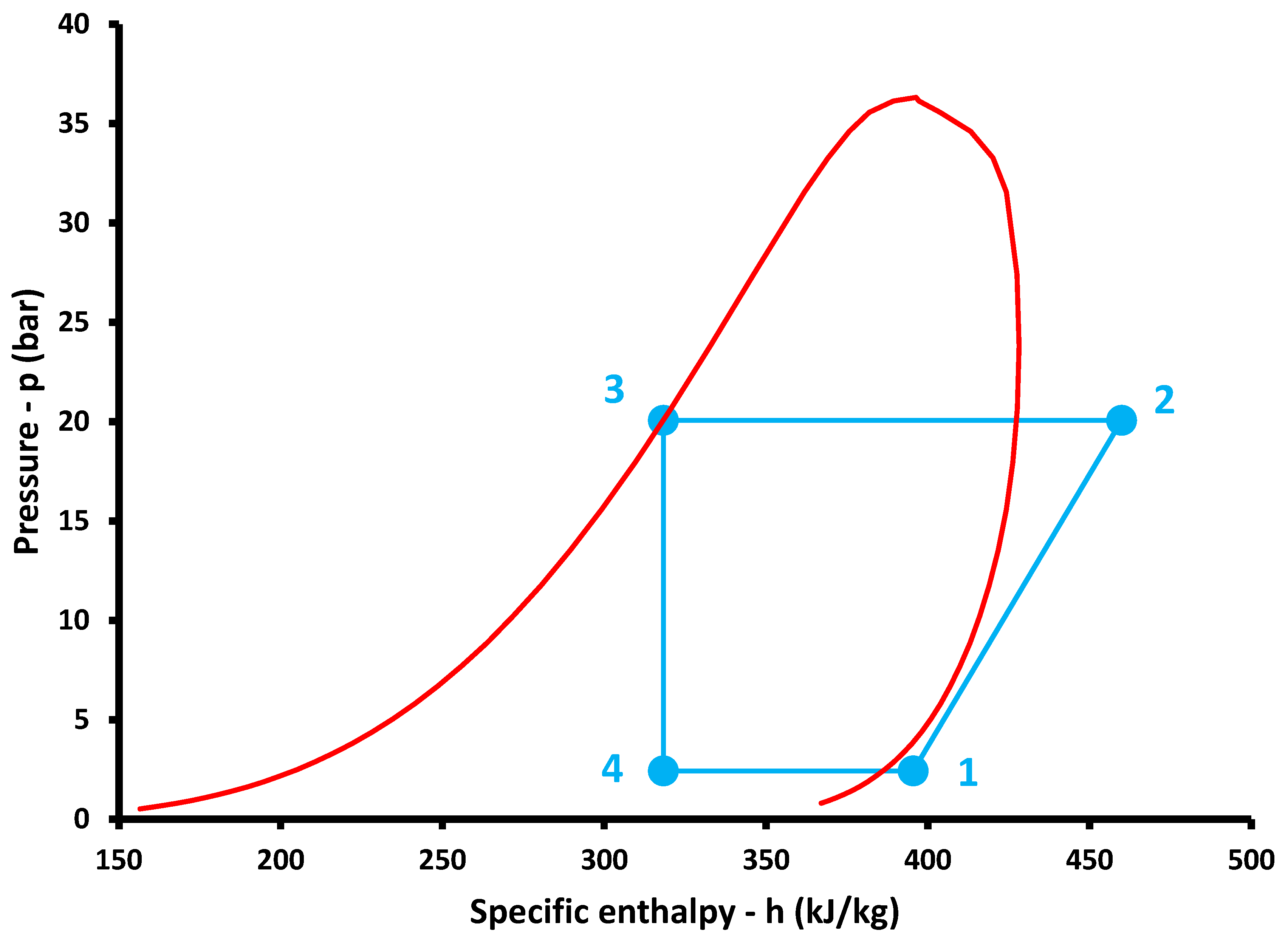

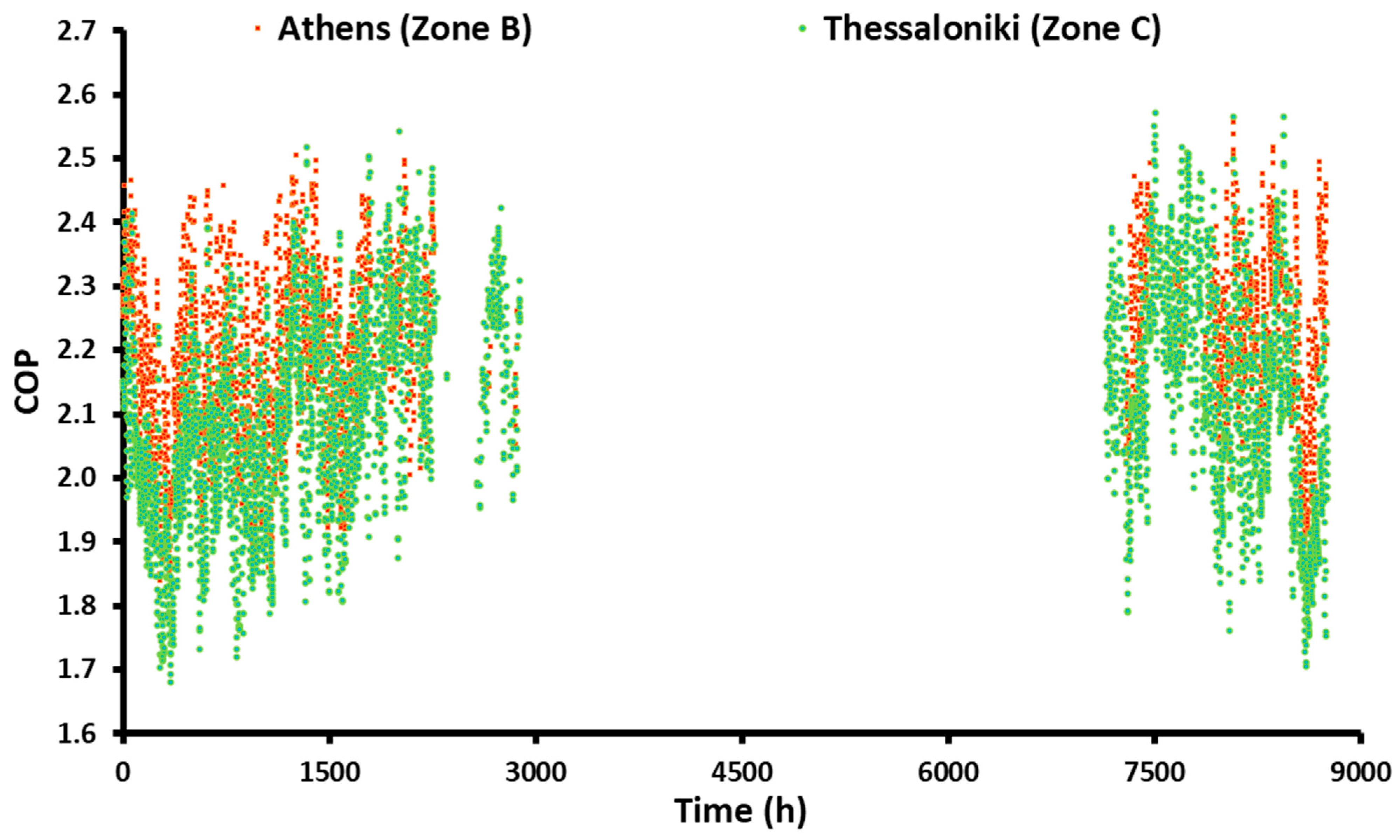
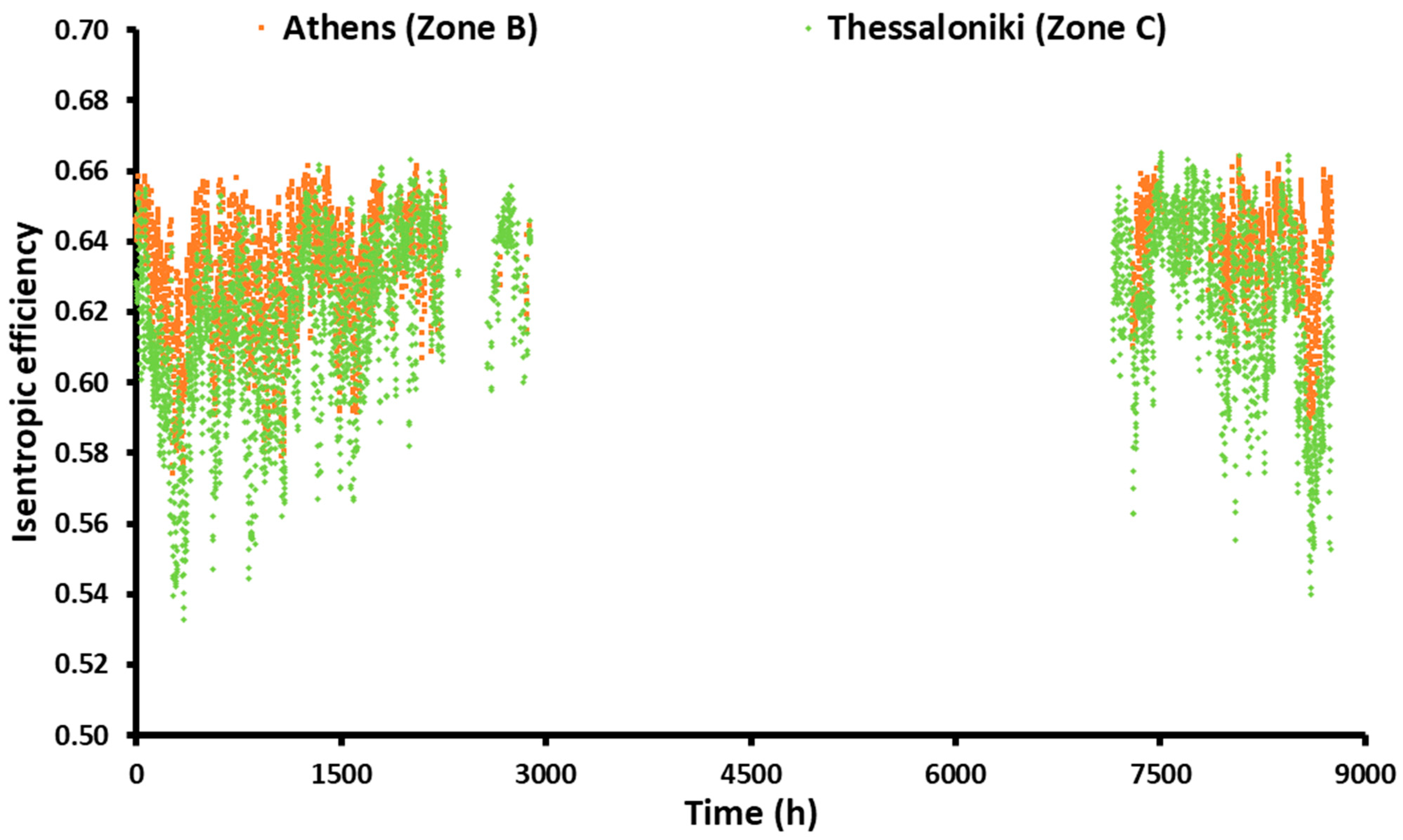
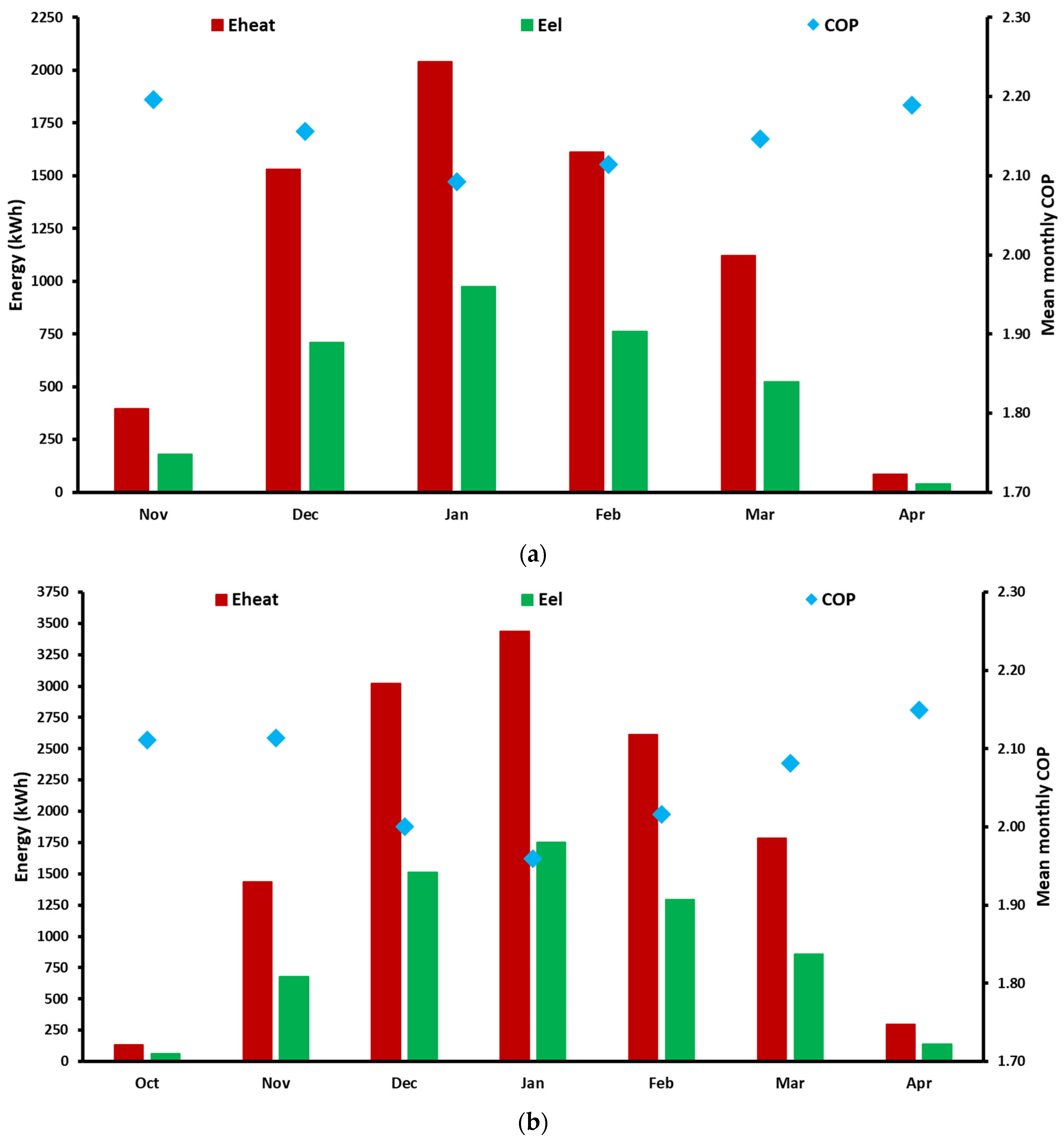

| Structural Element | Materials | Thickness (cm) | k (W/mK) | ρ (kg/m3) | cp (kJ/kgK) | U (W/m2 K) |
|---|---|---|---|---|---|---|
| Roof | Concrete | 20 | 2.1 | 2400 | 0.8 | 0.392 |
| Insulation | 8 | 0.035 | 40 | 0.8 | ||
| Ground | Floor | 1.5 | 0.07 | 800 | 1.0 | 0.399 |
| Concrete | 25 | 2.1 | 2400 | 0.8 | ||
| Insulation | 7 | 0.035 | 40 | 0.8 | ||
| Wall | Plaster | 1 | 1.389 | 2000 | 1.0 | 0.441 |
| Brick | 10 | 0.889 | 1800 | 1.0 | ||
| Insulation | 6.5 | 0.035 | 40 | 0.8 | ||
| Brick | 10 | 0.889 | 1800 | 1.0 | ||
| Plaster | 1 | 1.389 | 2000 | 1.0 |
| Structural Component | Materials | Thickness (cm) | k (W/m K) | ρ (kg/m3) | cp (kJ/kg K) | U (W/m2 K) |
|---|---|---|---|---|---|---|
| Roof | Concrete | 25 | 2.1 | 2400 | 0.8 | 0.35 |
| Insulation | 9 | 0.035 | 40 | 0.8 | ||
| Ground | Floor | 1.5 | 0.07 | 800 | 1.0 | 0.392 |
| Concrete | 25 | 2.1 | 2400 | 0.8 | ||
| Insulation | 10 | 0.035 | 40 | 0.8 | ||
| Wall | Plaster | 1 | 1.389 | 2000 | 1.0 | 0.298 |
| Brick | 10 | 0.889 | 1800 | 1.0 | ||
| Insulation | 7.5 | 0.035 | 40 | 0.8 | ||
| Brick | 10 | 0.889 | 1800 | 1.0 | ||
| Plaster | 1 | 1.389 | 2000 | 1.0 |
| Parameter | Value |
|---|---|
| Heating set point temperature | 20 °C |
| Floor area | 225 m2 |
| Length of the building | 15 m |
| Width of the building | 15 m |
| Height of the building | 3 m |
| Window area in the south wall | 8 m2 |
| Infiltration and natural ventilation rate | 1 ACH |
| Appliances and lighting specific gain | 7 W/m2 |
| Occupancy | 4 occupants |
| Specific load per occupant | 100 W/person |
| U-values of the ground (Athens) | 0.399 W/m2 K |
| U-value of the roof (Athens) | 0.392 W/m2 K |
| U-value of the external walls (Athens) | 0.441 W/m2 K |
| U-values of the ground (Thessaloniki) | 0.298 W/m2 K |
| U-value of the roof (Thessaloniki) | 0.350 W/m2 K |
| U-value of the external walls (Thessaloniki) | 0.392 W/m2 K |
| U-value of the window (Athens) | 2.6 W/m2 K |
| U-value of the window (Thessaloniki) | 2.4 W/m2 K |
| g-value of the window | 75% |
| Parameter | Athens | Thessaloniki | ||
|---|---|---|---|---|
| Heat Pump | Oil Boiler | Heat Pump | Oil Boiler | |
| Heating load (kWh/year) | 6785 | 6785 | 12,591 | 12,591 |
| Electricity demand (kWh/year) | 3189 | - | 6299 | - |
| Oil demand (kWh/year) | - | 9046 | - | 16,965 |
| Primary energy demand (kWh/year) | 9247 | 9951 | 18,267 | 18,661 |
| Mean yearly COP | 2.128 | - | 2.013 | - |
| LCC (EUR) | 18,196 | 24,644 | 33,055 | 46,216 |
| Lifetime CO2 emissions (kgCO2) | 38,823 | 59,706 | 76,690 | 111,968 |
| Parameter | Athens | Thessaloniki |
|---|---|---|
| Lifetime primary energy reduction (kWh) | 17,588 | 9857 |
| Lifetime net savings (EUR) | 6448 | 13,161 |
| Simple payback period of the investment (years) | 8.03 | 6.11 |
| Lifetime CO2 emissions reduction (kgCO2) | 20,882 | 35,278 |
Disclaimer/Publisher’s Note: The statements, opinions and data contained in all publications are solely those of the individual author(s) and contributor(s) and not of MDPI and/or the editor(s). MDPI and/or the editor(s) disclaim responsibility for any injury to people or property resulting from any ideas, methods, instructions or products referred to in the content. |
© 2023 by the authors. Licensee MDPI, Basel, Switzerland. This article is an open access article distributed under the terms and conditions of the Creative Commons Attribution (CC BY) license (https://creativecommons.org/licenses/by/4.0/).
Share and Cite
Bellos, E.; Tsimpoukis, D.; Lykas, P.; Kitsopoulou, A.; Korres, D.N.; Vrachopoulos, M.G.; Tzivanidis, C. Investigation of a High-Temperature Heat Pump for Heating Purposes. Appl. Sci. 2023, 13, 2072. https://doi.org/10.3390/app13042072
Bellos E, Tsimpoukis D, Lykas P, Kitsopoulou A, Korres DN, Vrachopoulos MG, Tzivanidis C. Investigation of a High-Temperature Heat Pump for Heating Purposes. Applied Sciences. 2023; 13(4):2072. https://doi.org/10.3390/app13042072
Chicago/Turabian StyleBellos, Evangelos, Dimitrios Tsimpoukis, Panagiotis Lykas, Angeliki Kitsopoulou, Dimitrios N. Korres, Michail Gr. Vrachopoulos, and Christos Tzivanidis. 2023. "Investigation of a High-Temperature Heat Pump for Heating Purposes" Applied Sciences 13, no. 4: 2072. https://doi.org/10.3390/app13042072









